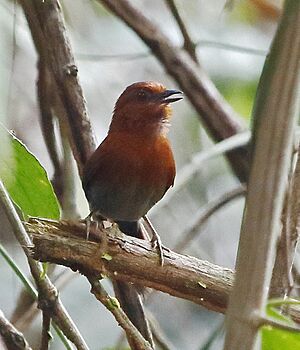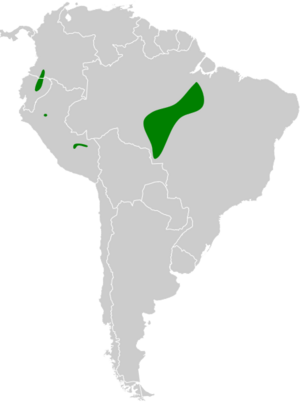Chestnut-throated spinetail facts for kids
Quick facts for kids Chestnut-throated spinetail |
|
|---|---|
 |
|
| at Carajás Mountains, Pará state, Brazil | |
| Conservation status | |
| Scientific classification | |
| Genus: |
Synallaxis
|
| Species: |
cherriei
|
 |
|
The chestnut-throated spinetail (Synallaxis cherriei) is a small bird that belongs to the ovenbird family. It is mostly found in parts of Bolivia, Brazil, Colombia, Ecuador, and Peru.
Contents
About the Chestnut-throated Spinetail
Scientists group animals together based on how they are related. The chestnut-throated spinetail is closely related to other spinetail birds, like the stripe-breasted spinetail and the ruddy spinetail.
Some scientists believe there are three slightly different types of chestnut-throated spinetails. These types are called subspecies. Other scientists think there are only two. In this article, we will talk about the three subspecies.
What Does the Spinetail Look Like?
The chestnut-throated spinetail is about 13 to 15 centimeters (5 to 6 inches) long. It weighs about 14 to 17 grams (0.5 to 0.6 ounces).
- Head and Throat: Adult males have a deep reddish-brown color on their forehead, face, and throat.
- Body: Their back and the top of their head are also reddish-brown, but with a bit of olive-brown. Their lower back is dark brown.
- Wings and Tail: Their wings are mostly reddish-brown, and their flight feathers are dark. The tail is dark gray, pointed, and gets shorter towards the end.
- Belly: Their chest is a deep reddish-brown. Their belly is gray with a hint of olive-brown.
- Eyes and Beak: Their eyes can be ivory gray or dark brown. The top part of their beak is black, and the bottom part is dark gray. Their legs and feet are dusky olive to brownish-gray.
Female spinetails look very similar to males, but their throat and belly are a bit lighter. Young spinetails have darker, more olive-brown upper parts. Their throat is whitish, and their belly feathers have faint brown edges.
There are also slight differences between the subspecies:
- S. c. napoensis has more reddish-brown on its forehead and a darker belly.
- S. c. saturata is lighter overall and browner than the main type. It has a more orange-reddish throat and chest, and a lighter gray belly.
Where Do Spinetails Live?
The chestnut-throated spinetail lives in separate areas, not all connected.
- The most common subspecies lives in the central Amazon Basin in Brazil.
- Another subspecies lives in southern Colombia and in Ecuador.
- A third subspecies is found in northern and central Peru and northern Bolivia.
These different groups of spinetails live in different kinds of places:
- In the Brazilian Amazon, they mostly live in "terra firme" forests. These are forests on higher ground that don't flood. They especially like areas with Chusquea bamboo.
- In the western areas, they prefer thick plants in the lower parts of lowland and foothill forests. They can be found at the edges of untouched forests and inside forests that are regrowing. In these areas, they don't seem to prefer bamboo.
Spinetail Behavior
Movement and Daily Life
The chestnut-throated spinetail stays in the same area all year round. It does not migrate.
What Do Spinetails Eat?
This bird eats arthropods, which are small creatures like insects and spiders. They usually look for food in pairs. They often stay hidden in thick plants, usually within 3 meters (10 feet) of the ground. Sometimes, they search for food on the ground or as high as 8 meters (26 feet) up in the trees.
How Do Spinetails Raise Their Young?
Not much is known about how chestnut-throated spinetails breed. Young birds have been seen with adults in May and June.
What Do Spinetails Sound Like?
The song of the chestnut-throated spinetail sounds like "prruh-pih," with the second note being higher. They sing this in long series with short breaks. When they are looking for food, their calls include a high-pitched "psiu" and "piwwwh."
Spinetail Conservation Status
The IUCN (International Union for Conservation of Nature) keeps track of how many animals are left in the wild.
- In 1988, they thought the chestnut-throated spinetail was "Threatened."
- In 2004, they changed it to "Near Threatened."
- Since 2021, it has been listed as "Least Concern." This means it is not currently in danger of extinction.
Even though it is "Least Concern," the number of these birds is believed to be going down. The biggest threat to them is deforestation, which is when forests are cut down. This is especially a problem for the smaller groups of spinetails living outside the central Amazon.
The chestnut-throated spinetail seems to be more affected by its habitat being broken into small pieces than by just being disturbed. If bamboo, which some spinetails rely on, dies off in a small forest piece, the birds might get stuck. They might not be able to cross open areas to find new, suitable homes.


